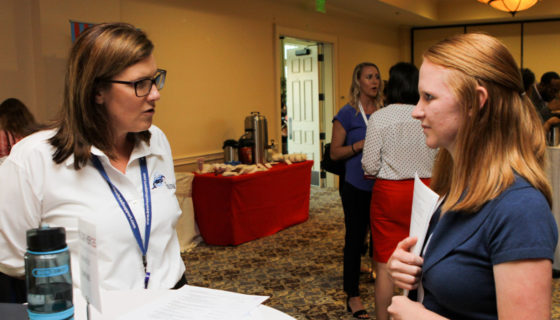Hiring Our Heroes Program Managers Share Their Best Elevator Pitch Tips

It doesn’t matter if you’re leaving the military tomorrow or 10 years from now – you need to have your elevator pitch ready.
Even if you aren’t looking for a job. Even if you love your job.
You need to have your elevator pitch ready so that when someone asks “What do you do?” at a neighborhood block party, a networking reception, or your best friend’s wedding, you can fire back with a confident answer.
But answering that question, “What do you do?” can be especially hard for transitioning service members.
With this in mind, we turned to the elevator pitch experts at Hiring Our Heroes – the program managers at our Corporate Fellowship Program – and asked them to share their best tips for effective elevator pitches.
Your Pitch Should Sound Like You, Not a Memorized Script
No one wants to hear this, but we’re still going to say it anyway – practice your pitch. CFP program managers recommended that a transitioning service member take 20 minutes to write down their elevator pitch. Once you finish writing it, practice it.
Record yourself reciting your elevator pitch. Listen for parts when you stumble over your words. Then practice those sections of your elevator pitch again.
Don’t be afraid to practice your elevator pitch with your spouse, friends, and other veterans. Hiring Our Heroes provides many opportunities to develop and practice your elevator pitch at professional development events. Find a Hiring Our Heroes event near you today.
Related: How to Make Your Story Stand Out for Hiring Managers
Don’t forget to time your elevator pitch. If it’s longer than 20 seconds, revise it.
Your Elevator Pitch Should Naturally Invite the Other Person to Ask Questions
For example, if you’re a transitioning logistician, the conversation may go like this:
Employer: “Hi, nice to meet you. What do you do?”
Service member: “Hi, I’m Lindsay Teplesky and I move products from point A to point B so that our customers can get the job done.”
Employer: “Cool! How do you do that?”
Service member: “I’m a logistician in the Army, but I’m getting ready to transition to the civilian world. I’m hoping to continue in the supply chain field, hopefully in a role in which I can leverage my Lean Six Sigma certification.”
Notice how this elevator pitch evokes a conversation. You are talking with the person, not at the person. Plus you are sprinkling in details about your professional certifications and experiences (like Lean Six Sigma certification) throughout the three- to five-minute interchange.
“I find this is much better received than a service member just regurgitating their resume,” Teplesky said.
Use “The Warm Up” Technique at Crowded Hiring Fairs and Busy Networking Receptions
Your elevator pitch is an invitation to connect. But many times, at crowded hiring fairs and networking receptions, you barely have enough elbow room, let alone the space and time to connect with a hiring manager.
In these situations, CFP program manager Rob Comer advises transitioning service members to use a technique he calls “The Warm Up.”
The Warm Up consists of three steps:
- The hiring event may be noisy with people waiting in lines. So, before you talk to anyone, walk around casually, listen to conversations, and observe mannerisms to sort of “get in a rhythm.”
- When you’re ready, seek out a company with no lines and start up a conversation. This is probably not your target, so you will feel less pressured about your pitch.
- If you are still feeling awkward or uncomfortable, talk with a Veteran Service Organization at the event.
“I remember my first job fair when I was getting out. I struck up a conversation with a nonprofit veteran mentorship organization. They were very warm and conversational. That conversation gave me a boost and some confidence to talk some employers,” Comer said.
Replace Your MOS Code and Rank with Your Post-Military Goal
While corporations want to hire military talent, the hiring manager most likely doesn’t have any military-related experience.
They won’t hire you if they don’t understand what you did in the military, said Stefanie Watson, CFP program manager. Watson said that service members need to remember to keep their elevator pitch simple.
“Brevity is key. Don’t get too technical or you will lose them from the start,” she said.
The key is to know your audience. You may want to have several different elevator pitches prepared and ready for different audiences. Each elevator pitch would highlight different skills and abilities.
Related: 3 Things that Make the Corporate Fellowship Program a Unique Experience for Transitioning Service Members
CFP program manager Carla Miller said she encourages transitioning service members to take their military rank out of their elevator pitch. Include your branch of service, followed by what you have done and can do in the career field you are looking to go into. Don’t talk about prior work experience if it doesn’t align with your professional goals.
“For example, if you are not interested in HR, your elevator pitch should not be about your 20 years of HR experience in the Air Force,” Miller said.
End Your Elevator Pitch with a Statement of Continued Dialogue
An elevator pitch is your first interaction, but it shouldn’t be your only interaction. Studies show that the majority of transitioning service members do not follow up when networking.
For example, if someone gives you their business card, ask if you can connect with them on LinkedIn. If you meet a veteran at a hiring event, invite them to meet for coffee next week.
If you keep your sights set on the next conversation, your elevator pitch will be a successful one.



